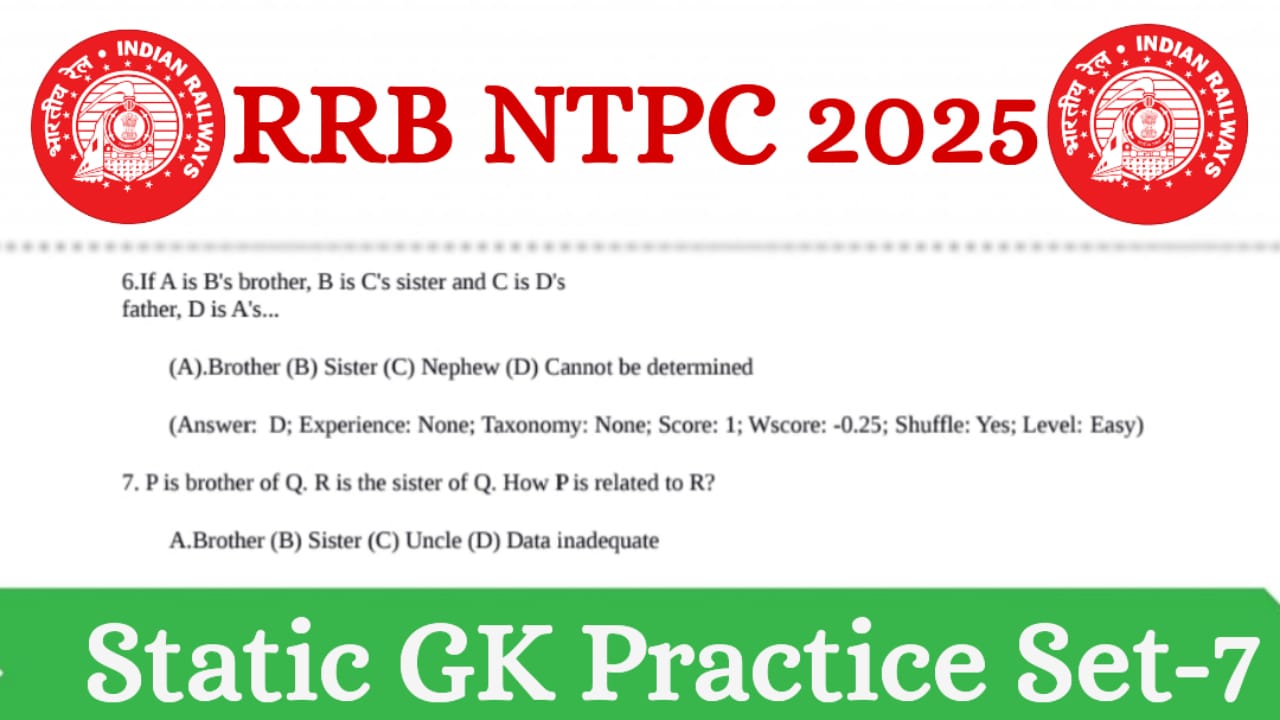RRB NTPC 2025 Static GK Practice Set-7: The RRB NTPC 2025 Static GK Practice Set-7 is designed to help candidates prepare effectively for the upcoming CBT (Computer-Based Test) exam. This set includes a variety of questions focused on Static General Knowledge, covering Indian history.
By practicing with this set, aspirants can enhance their knowledge, boost confidence, and improve accuracy in answering GK-related questions during the exam. It is an essential resource for candidates aiming to secure a position in the Indian Railways through the RRB NTPC exam.
RRB NTPC 2025 Static GK Practice Set-7
Here are the MCQs:
- Who is the most important God in Rigveda?
A. Agni
B. Indra
C. Varun
D. Vishnu - ‘Ayurveda’ has its origin in
A. Rig Veda
B. Sama Veda
C. Yajur Veda
D. Atharva Veda - Which one of the following is described in Upanishad?
A. Dharma
B. Yoga
C. Philosophy
D. Law - The staple food of the Vedic Aryan was—
A. Barley and rice
B. Rice and pulses
C. Milk and its products
D. Vegetables and fruits - Which of the following Vedas deals with magic spells and witchcraft?
A. Rigveda
B. Samaveda
C. Yajurveda
D. Atharvaveda - The Vedic religion along with its Later (Vedic) developments is actuallynknown as
A. Hinduism
B. Brahmanism
C. Bhagavatism
D. Vedic Dharma - Which of the following is the major impact of Vedic Culture on Indian History?
A. Progress of philosophy
B. Development of culture
C. Rigidification of caste system
D. Perception of a new world - The Vedic economy was based on
A. Trade and commerce
B. Crafts and industries
C. Agriculture and cattle rearing
D. All the above - Match list ‗A‘ with list ‗B‘ and choose the correct answer from the codes given below:
List ‗A‘ List ‗B‘
a. Shiksha 1. Ritual
b. Kalpa 2. Grammar
c. Vyakarana 3. Pronunciation
d. Nirukta 4. Metre
e. Chhanda 5. Astronomy
f. Jyotisha 6. Etymology
Codes: a b c d e f
A. 1 2 3 5 5 4
B. 3 1 2 6 4 5
C. 5 6 3 4 1 2
D. 6 5 4 3 2 1 - The normal form of government during the Vedic period was
A. Democracy
B. Republics
C. Oligarchy
D. Monarchy - Two popular Assemblies of the Vedic period were
A. Sabha and Mahasabha
B. Mahasabha and Ganasabha
C. Sabha and Samiti
D. Ur and Kula - Which of the following Brahmana texts belongs to Atharvaveda?
A. Shatpath
B. Aitareya
C. Gopatha
D. Panchavinsh - Dasarajana was:
A. Ten incarnations of Vishnu
B. A sacrifice to be performed by the king
C. Battle of ten kings
D. None of these - The world is god and god is my soul’ is the philosophy contained in the:
A. Vedas
B. Puranas
C. Brahamanas
D. Upanishads - The mediator between man and gods according to the Vedic people was :
A. Inra
B. Agni
C. Marut
D. Asvins - Which of the oldest Vedha?
A. Samaveda
B. Yajurveda
C. Atharvaveda
D. Rigveda - Which one of the following was the main characteristic of the later Vedic age?
A. Varna system
B. Tribal polity
C. Caste system
D. Food gathering practice - The word ‘Vid’ from which ‘Veda’ has been derived means:
A. God
B. Doctrine
C. Knowledge
D. Holy - The Aryans came to India from:
A. Eastern Europe
B. Central Asia
C. South-east Asia
D. None of these - Which of the following is not a feature of Hinduism?
A. Reverence for Veda
B. Belief in God
C. Emphasis on ritualism
D. Doctrine of ahimsa
Suggested Post: RRB NTPC 2025 Static GK Practice Set-6 for CBT Exam
Answers to the RRB NTPC 2025 Static GK Practice Set-7
Here are the Answer
- B. Indra
- D. Atharva Veda
- C. Philosophy
- C. Milk and its products
- D. Atharvaveda
- B. Brahmanism
- C. Rigidification of caste system
- C. Agriculture and cattle rearing
- B. 3 1 2 6 4 5
- D. Monarchy
- C. Sabha and Samiti
- C. Gopatha
- C. Battle of ten kings
- D. Upanishads
- B. Agni
- D. Rigveda
- C. Caste system
- C. Knowledge
- B. Central Asia
- D. Doctrine of ahimsa
| Join Our Telegram Channel | Click Here |
| Join Our WhatsApp Group | Click Here |

